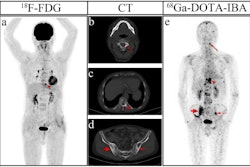
PET/CT is more accurate than bone scintigraphy for detecting bone metastases in patients with prostate cancer, according to a study published May 20 in the Journal of Medical Imaging and Radiation Sciences.
A group at Dalhousie University in Halifax, Canada, reviewed existing literature for studies comparing gallium-68 (Ga-68) prostate-specific membrane antigen (PSMA) PET/CT and technetium-99m (Tc-99m) methyl diphosphonate (MDP) bone scintigraphy in prostate cancer patients. Findings suggest imaging departments should consider transitioning to Ga-68 PSMA-11 PET/CT, according to the researchers.
"Because Ga-68 PSMA-PET/CT has been incorporated into clinical practice before a comprehensive synthesis had been conducted, our study sought to put this proverbial horse in front of the cart," the group wrote.
One of the most common places for prostate cancer cells to metastasize to is bone, specifically the axial skeleton (ribs, pelvis, and spine, where red marrow is most abundant), the authors explained.
Bone scintigraphy has been the standard diagnostic approach for decades for detecting prostate cancer bone metastases, yet numerous studies have suggested that Ga-68 PSMA-PET/CT may be superior, with the approach quickly deployed clinically after its U.S. approval in 2020. However, there have been no systematic reviews comparing the two approaches, according to the authors.
To address this shortcoming, the group combed the literature for comparative studies between September 2011 to July 2022. For inclusion, they focused on studies that reported accuracy data (sensitivity, specificity, negative predictive value, and positive predictive value) in patients, with image acquisitions between the two modalities performed within three months of each other.
The researchers identified five single-centered studies that met these criteria. In total, the studies included 451 patients at varying treatment and diagnosis stages. Across all measures of accuracy, Ga-68 PSMA PET/CT was superior to Tc-99m MDP bone scintigraphy in the detection of skeletal metastases, they found.
| Patient-based sensitivities and specificities for detecting bone metastases | ||
| Tc-99m MDP bone scintigraphy | Ga-68 PSMA-PET/CT | |
| Sensitivity | 50%-91% | 91%-100% |
| Specificity | 19%-96% | 88%-100% |
"Ga-68 PSMA-PET/CT was more accurate than Tc-99m MDP bone scintigraphy in the detection of [prostate cancer] bone metastases," the authors stated.
Ultimately, costs associated with PET/CT technology are the main limitation for using the approach in most healthcare centers, according to the authors. For example, in Nova Scotia, there is one PET/CT scanner to support a population of more than 1 million people, they noted.
Nonetheless, the question that needs to be answered is whether bone scintigraphy, with inferior accuracy, is a sufficient standard of care, they wrote.
"As the superiority of Ga-68 PSMA-PET/CT becomes more widely recognized, diagnostic imaging departments may consider a transition to this procedure," the researchers concluded.





















